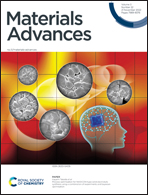Mesoporous β-Ag2MoO4 nanopotatoes as supercapacitor electrodes†
Abstract
A growing quest for supercapacitors capable of quickly transferring energy has led to investigations focusing on developing electrode materials that incorporate noble metals due to their superior electrical conductivity. Here, we report the synthesis and charge storage performance of mesoporous silver molybdate electrodes of cubic β-Ag2MoO4 morphology and potatoes-like nanostructures. The electrochemical performance of the mesoporous β-Ag2MoO4 electrode has a battery-type behaviour with the transfer of two electrons (Ag0 ↔ Ag2+) during the redox reaction in 2 M KOH aqueous solution within a potential range of −0.45 to 0.35 V. In addition, the electrodes demonstrate quasi-conversion reaction during the discharge, which is due to the oxidation of unoxidized Ag0. Furthermore, the electrodes exhibit a maximum specific capacity of 2610 C g−1 at 1 A g−1 and significant retention of 82% upon 5000 continuous galvanostatic charge/discharge (GCD) cycles. A battery-type asymmetric supercapacitor cell (BASC) was designed using β-Ag2MoO4 as the positive electrode, activated carbon as the negative electrode, and polyurethane foam/KOH as the separator-cum-charge reservoir. The fabricated BASCs yielded maximum specific energy of 54 W h kg−1 at a specific power of 194 W kg−1. These appreciable electrochemical features suggest that β-Ag2MoO4 can be a viable material for developing supercapacitor electrodes.



 Please wait while we load your content...
Please wait while we load your content...